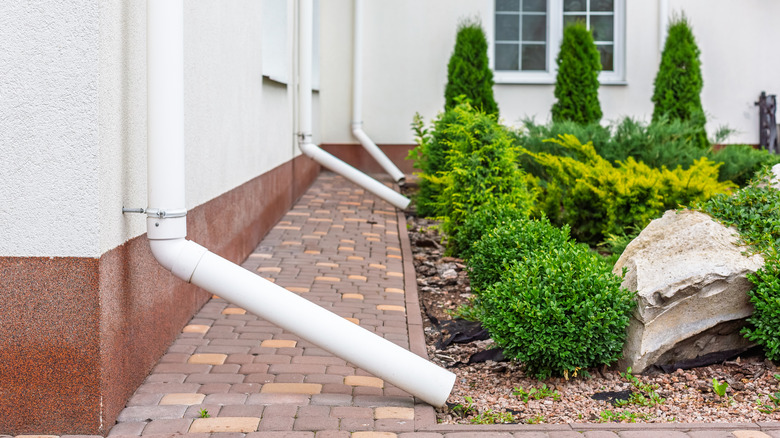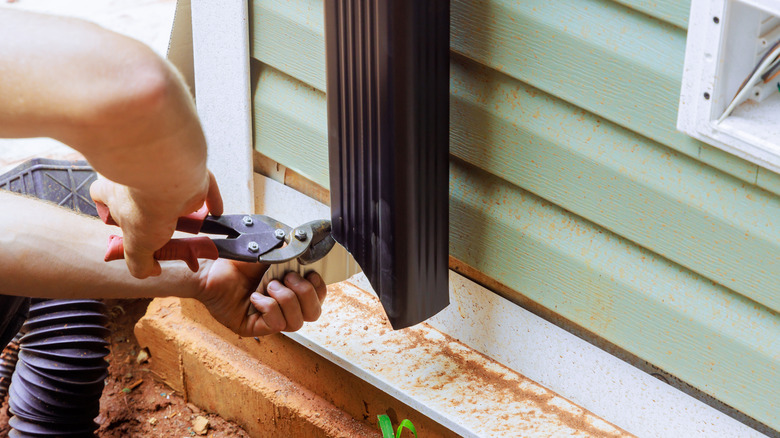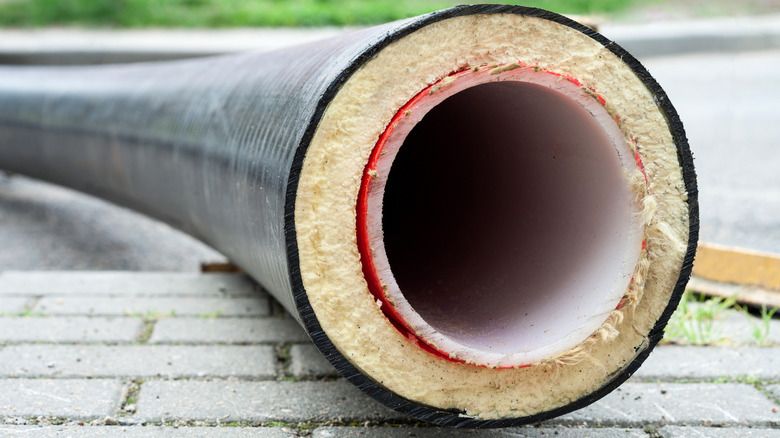Simple Tips To Make A Loud Gutter Downspout Quieter
It can feel impossible to get used to the sound of a trickling or dripping gutter downspout. If you're sensitive to these types of noises, there are a few DIY fixes you can try to reduce these sounds around your home, specifically when it comes to irritating gutter sounds. A noisy drainage system can be rooted in several distinct causes, including a loosely connected downspout or a noisy pipe elbow, both of which you can fix on your own. Besides the unwanted sounds, a loud gutter can also indicate a deeper problem, like improper installation. It's important to determine the root cause of this smaller symptom, reducing the risk of it turning into a more in-depth and expensive project.
The roles of gutters and downspouts are to defend your home from any water damage, channeling rainwater safely down to the ground. Gutters run horizontally alongside the eaves of your roof, while downspouts run vertically to the ground or drainage systems, keeping the water from pooling around your home's foundation. To keep these pieces running smoothly and, most importantly, quietly, you can try a few different tactics: fixing the angle of the downspout, replacing pieces of the downspout, inserting rope inside the downspout, or adding a sponge to the bottom to absorb excess falling water.
Adjust the downspout angle
One of the most common reasons you are hearing constant dripping and trickling from your gutter and downspout is due to the pipe's angle. The pipe might be positioned in a way that allows water to land on the metal, or it is placed too vertically, increasing the chance of noise. When the water falls directly down the downspout, it can be loud. To adjust this, you can either reposition the bottom of the spout or add new sections to reroute the pipe to another area farther away.
While there is always the option to remove your entire pipe to reroute it completely, you can also just adjust the existing pipe or consider a downspout extension. To extend the pipe, connect your new downspout pieces to the old pipe using a crimper tool (or needle-nose pliers in a pinch). You can also use clips or spacers if you only need to extend the pipe a small distance. If this type of project seems a little too out of your comfort zone, it's always advised to ask a professional.
Soften sound with a sponge
One of the easiest tactics for solving the problem of a dripping downspout is to absorb the excess dripping water. Since downspouts are typically made of metal, like steel or aluminum, the falling water can be quite noisy, even if it's outside. You can silence your drippy downspout by inserting an absorbent material at the bottom of the vertical pipe or in the elbow, which is the L-shaped section at the bottom of the downspout.
There are a few options you can choose from, and some you may already have lying around your home or in your garage. One of the most common options is an old scrubber sponge, which you can glue to the interior of the pipe. You can also use a foam downspout insert, a square of artificial turf, or part of a shingle. While these temporary methods will work for a bit, you will most likely need to replace the item regularly or turn to a more long-term method, like a nylon rope.
Muffle the sound with insulation
Similar to inserting a sponge or piece of turf into the elbow of your downspout to stop the trickling noise, you can also muffle the sound using insulation. This will decrease any surface vibrations and hopefully lower any irritating sounds. There are a few different ways to insulate your downspout. The first is to wrap your downspout with flexible foam pipe insulation or open-cell foam. If you're using the latter, you can secure it to the pipe using zip ties or tape. These should dampen the noises coming from your drainage system.
The second option is to use spray foam for the same purpose. Instead of fitting pieces of foam into the spout, you can use the spray version, which expands and hardens after it's sprayed. You can either apply it directly to the exterior of the downspout or on the inside to dampen the noises of the dripping water — just make sure you don't apply so much that you block the flow of the water through the pipe.
Add a nylon rope or chain
For a longer-term solution to your dripping water problem, you can use a strip of nylon rope to reduce the noise. The rope helps the water to smoothly flow down the pipe, as opposed to trickling against the downspout elbow. It will hopefully remove any irritating dripping noises.
Besides a length of nylon rope, which should ideally have a diameter of about ⅜ of an inch, you will also need caulk to secure it in place. You probably already have at least one of these items at home in your garage. First, apply your caulk to where the gutter and downspout meet. Secure one end of your piece of rope to the caulk and, once it's dried, insert the rope into the pipe. You can secure the other end of the rope at the bottom with additional caulk. If you don't enjoy the look of the rope sticking out of your gutter, you may want to look into more expansive options. You can also opt for a rain chain, which involves removing your downspout and replacing it with a chain for the water to drip down. You can even DIY your own rain chain with thrifted items like tea cups.




